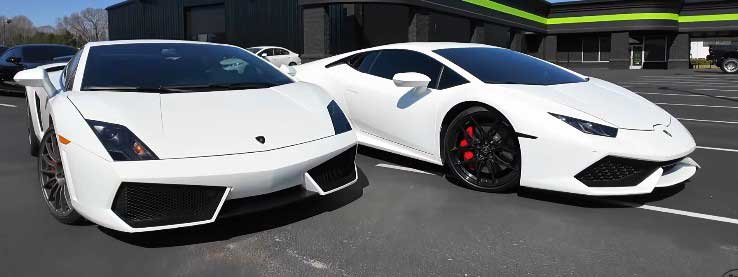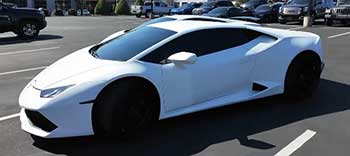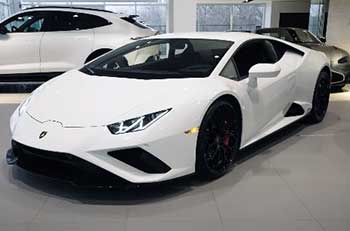My Experience with Lamborghini’s V10 Supercars: Gallardo vs. Huracán
I’ve always been captivated by the raw power and audacious style of Lamborghini’s supercars. The Gallardo and Huracán, two iconic V10 beasts, have defined the brand’s legacy for years. In this article, I’m sharing my firsthand journey comparing these legends, weighing their pros and cons, and analyzing their performance, design, and technology. Whether you’re a car enthusiast dreaming of owning one or just curious about what makes these machines tick, I’ll break it all down in a conversational, analytical way to help you understand which supercar might steal your heart.

Comparison Table: Lamborghini Gallardo vs. Huracán
| Feature | Lamborghini Gallardo (2003-2013) | Lamborghini Huracán (2014-2024) |
| Engine | 5.0L or 5.2L V10, 500-570 hp | 5.2L V10, 602-640 hp |
| Transmission | 6-speed manual or e-gear automated manual | 7-speed dual-clutch (LDF) |
| Drivetrain | AWD (LP560-4, LP570-4) or RWD (LP550-2) | AWD (LP610-4, Evo) or RWD (LP580-2, Evo RWD) |
| 0-60 mph | 3.4-3.7 seconds | 2.8-3.2 seconds |
| Top Speed | 202-204 mph | 202-211 mph |
| Weight | ~3,310-3,820 lbs | ~3,424-3,516 lbs |
| Base Price (Launch) | ~$165,900 (2003) | ~$237,000 (2014) |
| Interior | Analog gauges, basic infotainment | 12.3-inch TFT display, advanced connectivity |
| Aerodynamics | Basic, fixed components | Active aero (Performante, STO), improved drag |
| Suspension | Double wishbone, optional sports suspension | MagneRide, rear-wheel steering (select models) |
My Journey with Lamborghini’s V10 Supercars
I’ve been a car nut since I was a kid, sketching Lamborghinis in my notebook while dreaming of their roaring engines. The Gallardo and Huracán hold a special place in my heart because they represent Lamborghini’s “accessible” supercars—though let’s be real, “accessible” is relative when we’re talking six-figure price tags. These cars aren’t just vehicles; they’re rolling art, blending Italian flair with engineering brilliance.
The Gallardo, launched in 2003, was a game-changer, making Lamborghini a household name with its record-breaking sales.1 The Huracán, its successor, took that legacy and polished it with modern tech. Comparing them feels like pitting two rockstars against each other, each with its own swagger and story. I’m excited to share my take on these machines, having spent time behind the wheel and geeking out over their specs, to help you see what makes each one shine.
Lamborghini Gallardo Overview
The Gallardo hit the scene in 2003, and I remember the buzz it created. It was Lamborghini’s “baby” supercar, priced at around $165,900. This was a steal compared to the Murciélago’s $280,000 tag. Powered by a 5.0-liter V10 (later upgraded to 5.2 liters in models like the LP560-4), it churned out 500 to 570 horsepower, depending on the variant.2 I drove an early Gallardo SE, and the raw, unfiltered V10 growl was intoxicating—like a heavy metal concert in your ears.

The car’s all-wheel-drive system (with rear-wheel-drive options in the LP550-2) gave it tenacious grip.
However, the steering felt a tad heavy compared to today’s standards.
The Gallardo’s design is pure 2000s Lamborghini: sharp angles, low-slung stance, and a compact 172-inch length that made it feel nimble. Inside, it’s a time capsule—analog gauges, minimal infotainment, and a snug cabin that screamed driver focus over luxury.
The e-gear automated manual was clunky by modern standards. But the optional six-speed manual made every shift a visceral event. Over its decade-long run, Lamborghini sold 14,022 Gallardos, a record at the time, proving it was a hit with enthusiasts and collectors alike.
Pros of the Lamborghini Gallardo
- Raw Driving Experience: The Gallardo’s analog feel is a purist’s dream. The manual transmission option (rare in later models) makes every gear change a ritual. I loved the tactile feedback when rowing through gears in an LP550-2.
- Compact and Nimble: At 171.1-172 inches long and 74.8-75 inches wide, it’s easier to maneuver in tight spaces than larger Lambos. Parking in a crowded lot felt less like a heart attack.
- Iconic Status: As Lamborghini’s best-selling model until the Huracán, the Gallardo has a cult following. Its sharp, timeless design still turns heads.
- Affordable (Relatively): Used Gallardos start around $100,000 today, making them a “bargain” for a Lamborghini with V10 pedigree.
- Soundtrack: The 5.0-liter V10’s raspy, unrefined roar is distinct from the Huracán’s smoother tone. It’s pure emotion.
Cons of the Lamborghini Gallardo
- Outdated Technology: The infotainment is basic, with no touchscreen or modern connectivity. The pixelated display feels like a 2000s flip phone.
- Clunky Transmission: The e-gear automated manual is sluggish, with jerky shifts that disrupt the flow. Even the manual can feel notchy.
- Heavy Steering: The steering lacks the precision of newer supercars, making quick maneuvers less intuitive.
- Limited Comfort: The cabin is cramped, with minimal storage and harsh ride quality, even for a supercar. Long drives can be fatiguing.
- Maintenance Costs: Owning a Gallardo isn’t cheap. Routine maintenance, like clutch replacements, can cost $3,000-$4,000 or more, with annual service around $1,400.
Lamborghini Huracán Overview

Fast forward to 2014, and the Huracán stormed in as the Gallardo’s successor. I got to drive an LP610-4, and it felt like stepping into the future.
Its 5.2-liter V10, shared with the Audi R8, pumps out 602 to 640 horsepower, depending on the model (Evo, Performante, STO, or Tecnica).
The seven-speed dual-clutch transmission is lightning-fast, a huge leap over the Gallardo’s e-gear. With a 0-60 mph sprint as quick as 2.8 seconds in the Performante, the Huracán is a beast that feels glued to the road, thanks to its all-wheel-drive system and optional rear-wheel steering.
The Huracán’s design is sleeker, with Y-shaped LED headlights and a 185-inch length that’s slightly larger than the Gallardo. Its interior is a tech lover’s dream: a 12.3-inch TFT digital cockpit, borrowed from Audi, displays everything from navigation to performance stats. The Huracán also introduced active aerodynamics in models like the Performante, with ALA (Aerodinamica Lamborghini Attiva) boosting downforce by 750% over the standard model. It’s a supercar that balances daily drivability with track-ready ferocity.
Discover More: Lexus IS 350 vs. IS 500
Pros of the Lamborghini Huracán
- Blistering Performance: With up to 640 horsepower and a 0-60 time as low as 2.8 seconds, the Huracán (especially the Performante and STO) is a track monster.
- Advanced Technology: The 12.3-inch digital cockpit, Apple CarPlay, and Amazon Alexa integration make it feel like a modern supercar.
- Smooth Transmission: The seven-speed dual-clutch is buttery smooth yet razor-sharp, whether in Strada, Sport, or Corsa mode.
- Versatile Dynamics: ANIMA modes (Strada, Sport, Corsa) and optional MagneRide suspension let you tailor the drive from comfy to hardcore.
- Active Aerodynamics: Models like the Performante and STO use ALA to optimize downforce, giving unmatched stability at high speeds.
Cons of the Lamborghini Huracán
- Higher Price: Starting at $237,000 in 2014, the Huracán is pricier than the Gallardo was. Used models rarely dip below $200,000.
- Less Raw: The Huracán’s refined tech can feel less visceral than the Gallardo’s raw, mechanical soul.
- Complex Maintenance: The advanced electronics and active aero mean repairs are costly and require specialized technicians.
- Fuel Economy: At 15 MPG combined, it’s a gas guzzler, though if you’re buying a Lambo, you probably don’t care.
- Cabin Space: While improved over the Gallardo, it’s still tight, with limited storage for anything beyond a small bag.
Performance Comparison
When I floored the Gallardo LP560-4, its 552 horsepower shoved me back with a raw, unfiltered surge. The 0-60 mph sprint took about 3.7 seconds. Its top speed hit 202 mph. The Huracán LP610-4, with 602 horsepower, shaved that time to 2.8-3.2 seconds. Models like the Performante can reach 211 mph. The Huracán’s dual-clutch transmission snaps gears faster than I can blink, while the Gallardo’s e-gear felt like it was taking a coffee break between shifts.
The Huracán’s ANIMA system lets you switch between Strada (smooth), Sport (playful), and Corsa (track-focused) modes.4 This adapts the car’s throttle, steering, and suspension on the fly. The Gallardo lacks this versatility, sticking to a one-size-fits-all approach.
On a twisty road, the Huracán’s rear-wheel steering (in Evo and Tecnica models) and MagneRide suspension make it feel like it’s dancing. The Gallardo’s heavier steering and stiffer ride demand more muscle. For track days, the Huracán STO’s 640 horsepower and active aero make it untouchable, but the Gallardo’s simplicity has a charm that’s hard to beat for purists.
Design and Aesthetics
The Gallardo’s design is a love letter to the 2000s—sharp, angular, and aggressive. It has a low 45-inch height that screams supercar. Its slit-like side air intakes and compact stance give it a predatory look. I remember spotting one at a car show and being floored by its raw presence.
The Huracán, by contrast, is sleeker and more refined. It has Y-shaped headlights and a hexagonal motif that ties it to modern Lambos like the Revuelto. Its side intakes are larger. The optional active aero (ALA) subtly tweaks the bodywork for better downforce.
Inside, the Gallardo feels like a cockpit from a bygone era—analog gauges, minimal buttons, and Alcantara everywhere. The Huracán’s interior is a tech showcase, with a fighter-jet-inspired 12.3-inch TFT display and toggle switches that feel like they belong in a spaceship. The Huracán’s cabin is slightly roomier, with 1-2 inches more legroom, but both cars are tight for taller drivers like me. The Gallardo’s conventional doors are easier to live with than the Murciélago’s scissor doors, but the Huracán’s sleek lines and modern touches make it feel like a premium upgrade.
Technology and Features
The Gallardo’s tech is charmingly retro. Its infotainment is basic, with a small, pixelated screen and no touchscreen. You get a CD player and basic navigation, but don’t expect Apple CarPlay. The Huracán, on the other hand, is a tech geek’s dream. Its 12.3-inch digital cockpit, borrowed from Audi, offers customizable displays, Bluetooth, and Google Earth navigation. The Lamborghini Connect app lets you monitor your car remotely, and models like the Tecnica add exclusive HMI graphics.
The Huracán’s Piattaforma Inerziale (LPI) uses sensors to fine-tune handling, making it feel telepathic on the road. The Gallardo relies on raw mechanical grip, with no fancy sensors or adaptive systems. The Huracán’s optional Lamborghini Dynamic Steering (LDS) adjusts steering weight on the fly, while the Gallardo’s fixed steering feels dated. For safety, the Huracán offers basic driver aids like parking sensors, but neither car is big on nannies—Lamborghini expects you to drive, not cruise.
Driving Experience
Driving the Gallardo is like wrestling a bull—apt, given its name. The V10’s raspy howl fills the cabin, and the heavy steering makes every corner a workout. I took an LP550-2 through a mountain pass, and its rear-wheel-drive setup let me kick the tail out with a grin-inducing slide. But the e-gear’s sluggish shifts and stiff ride made long drives tiring.
The Huracán, by contrast, is a precision instrument. Its dual-clutch shifts are seamless, and the ANIMA modes let me dial in the perfect setup—Strada for cruising, Corsa for track attacks. The Performante’s ALA system kept it planted at 150 mph, something the Gallardo could only dream of.
For daily driving, the Huracán’s MagneRide suspension smooths out bumps better than the Gallardo’s rigid setup. But the Gallardo’s raw, unfiltered feedback makes it feel alive in a way the Huracán’s polished dynamics can’t match. If you want a car that feels like a time machine, the Gallardo delivers. If you crave cutting-edge performance, the Huracán is your pick.
Market Position and Value
The Gallardo was Lamborghini’s entry-level model, undercutting the Murciélago by over $100,000. Today, used Gallardos range from $100,000 to $200,000, depending on condition and model (SE, Superleggera, etc.). The Huracán started at $237,000, and used examples rarely dip below $200,000, with high-end models like the STO fetching $300,000+. The Gallardo’s lower price makes it a tempting entry into Lamborghini ownership, but its maintenance costs can rival the Huracán’s due to its age and simpler tech.
The Huracán’s modern features and performance make it a stronger competitor against rivals like the Ferrari 488 and McLaren 570S. The Gallardo, while iconic, feels outclassed by today’s supercars. If you’re after a collector’s piece, the Gallardo’s historical significance is hard to beat. For a daily-driver supercar, the Huracán’s refinement wins.
Industry Context
Lamborghini’s V10 supercars have always been about pushing boundaries. The Gallardo, launched under Audi’s ownership, brought stability and mass appeal to the brand, selling 14,022 units and outpacing the Murciélago. It competed with the Ferrari F430 and Porsche 911 Turbo, carving out a niche for drivers who wanted raw thrills without the V12 price tag. The Huracán, introduced in 2014, built on that success, matching the Gallardo’s sales in half the time. It took on the Ferrari 458, McLaren 650S, and Audi R8, blending track-ready performance with daily usability.
The supercar industry has evolved rapidly, with electrification looming. Lamborghini’s commitment to the V10 in the Huracán (and now the hybrid V8 Temerario) shows its dedication to emotional, high-revving engines. The Gallardo feels like a relic of a simpler era, while the Huracán bridges the gap between analog thrills and digital precision. Both cars embody Lamborghini’s ethos: bold, loud, and unapologetic.
Read More: Land Cruiser vs. Toyota Highlander
Frequently Asked Questions
It depends on your priorities. The Gallardo offers a raw, analog experience and is cheaper to buy, but the Huracán outshines it in performance, technology, and refinement
The Aventador and now Revuelto hold the crown for their V12 power and flagship status, but the Huracán’s versatility and sales make it a strong contender.
No, but they share roots. The Gallardo and second-gen Audi R8 use a similar 5.2-liter V10 and platform, but the R8 is more refined, while the Gallardo is rawer.
.
Conclusion
Comparing the Lamborghini Gallardo and Huracán has been a thrilling ride for me, and I hope you’ve enjoyed the journey too. The Gallardo, with its raw V10 growl and compact agility, captures the untamed spirit of early 2000s supercars. The Huracán, with its blistering speed and cutting-edge tech, feels like Lamborghini’s vision of the future. Whether you crave the nostalgic thrill of the Gallardo or the polished performance of the Huracán, both cars are legends in their own right. Pick the one that speaks to your soul—you can’t go wrong with either.

